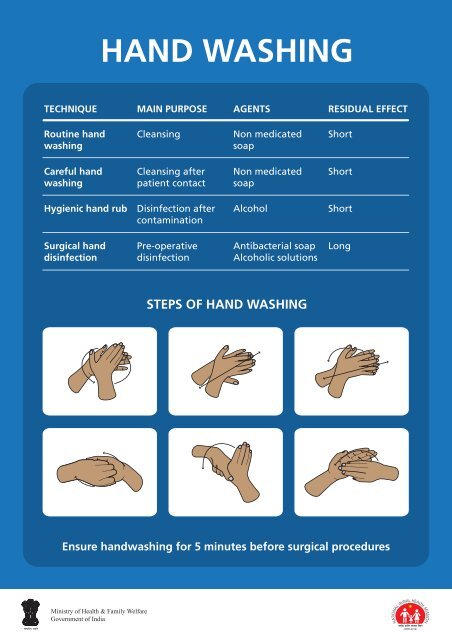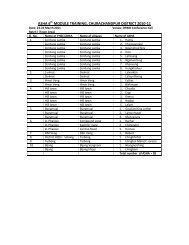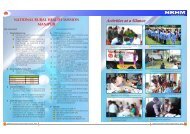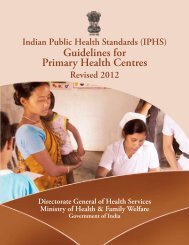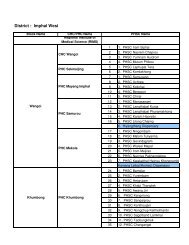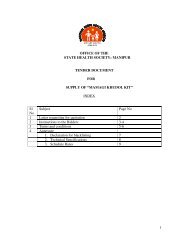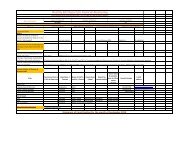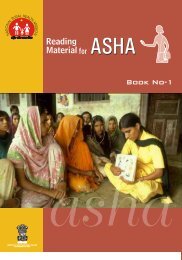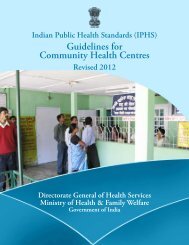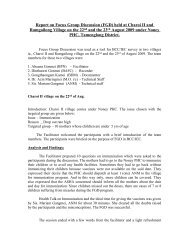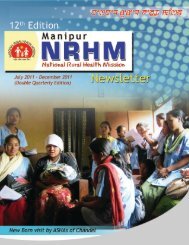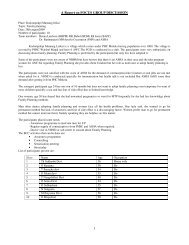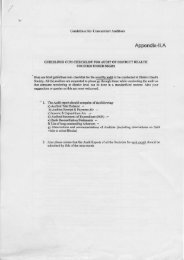Handwashing and SBA Posters - English.pdf
Handwashing and SBA Posters - English.pdf
Handwashing and SBA Posters - English.pdf
Create successful ePaper yourself
Turn your PDF publications into a flip-book with our unique Google optimized e-Paper software.
HAND WASHING<br />
TECHNIQUE<br />
MAIN PURPOSE AGENTS RESIDUAL EFFECT<br />
Routine h<strong>and</strong><br />
washing<br />
Cleansing<br />
Non medicated<br />
soap<br />
Short<br />
Careful h<strong>and</strong><br />
washing<br />
Cleansing after<br />
patient contact<br />
Non medicated<br />
soap<br />
Short<br />
Hygienic h<strong>and</strong> rub<br />
Disinfection after<br />
contamination<br />
Alcohol<br />
Short<br />
Surgical h<strong>and</strong><br />
disinfection<br />
Pre-operative<br />
disinfection<br />
Antibacterial soap<br />
Alcoholic solutions<br />
Long<br />
STEPS OF HAND WASHING<br />
Ensure h<strong>and</strong>washing for 5 minutes before surgical procedures
INFECTION PREVENTION<br />
Puncture Proof Container<br />
H<strong>and</strong> washing<br />
H<strong>and</strong> Washing<br />
Use of protective attire<br />
Safe Disposal Unit<br />
Transparent plastic container<br />
with a locking system<br />
All Needles <strong>and</strong> Sharps<br />
I.V. Cannulas<br />
Broken Ampoules<br />
All Blades<br />
Proper h<strong>and</strong>ling <strong>and</strong><br />
disposal of sharps<br />
Ensuring general cleanliness<br />
(walls, floors, toilets,<br />
<strong>and</strong> surroundings)<br />
Protective Attire<br />
Needle Destroyer<br />
Bio-Medical Waste disposal<br />
- Segregation<br />
- Disinfection<br />
- Proper storage<br />
before transportation<br />
- Safe disposal<br />
Disposal Bag<br />
Yellow Bag<br />
Human tissue<br />
Placenta <strong>and</strong> PoCs<br />
Waste swabs / b<strong>and</strong>age<br />
Other items (surgical waste)<br />
contaminated with blood<br />
Black Bag<br />
Kitchen waste<br />
Paper bags<br />
Waste paper / thermocol<br />
Disposable glasses & plates<br />
Left over food<br />
Red Bag<br />
Disinfected catheters<br />
I.V. bottles <strong>and</strong> tubes<br />
Disinfected plastic gloves<br />
Other plastic material
PREPARATION OF 1 LITRE<br />
BLEACHING SOUTION<br />
Wear utility gloves <strong>and</strong> plastic apron.<br />
Take 1 litre of water in plastic bucket.<br />
Make thick paste in a plastic mug with<br />
3 level tea-spoons of bleaching powder<br />
<strong>and</strong> some water from the bucket.<br />
Mix paste in the bucket of water<br />
to make 0.5% chlorine solution.<br />
Maintain same ratio<br />
for larger volumes.
PROCESSING OF USED ITEMS<br />
DECONTAMINATION<br />
Soak in 0.5% chlorine solution<br />
for 10 minutes<br />
Thoroughly wash <strong>and</strong> rinse<br />
Wear gloves <strong>and</strong> other protective barriers<br />
Preferred Method<br />
Sterilisation<br />
Acceptable Method<br />
High Level Disinfection (HLD)<br />
Chemical<br />
Autoclave<br />
Dry Heat<br />
Boil or Steam<br />
Chemical<br />
Soak for<br />
10 - 24 hrs.<br />
106 kPa pressure<br />
121º C<br />
20 min. unwrapped<br />
30 min. wrapped<br />
170º C<br />
60 min.<br />
Lid on 20 min.<br />
Soak for 20 min.<br />
Cool<br />
(use immediately or store)
ANTENATAL EXAMINATION<br />
FUNDAL HEIGHT<br />
Preliminaries<br />
Ensure privacy<br />
Woman evacuates bladder<br />
Examiner st<strong>and</strong>s on right side<br />
Abdomen is fully exposed from xiphi-sternum to symphysis pubis<br />
weeks<br />
36 wk<br />
32 wk<br />
28 wk<br />
24 wk<br />
20 wk<br />
16 wk<br />
Patient’s legs are straight<br />
Centralise the uterus<br />
Fundal height in cms. corresponds<br />
to weeks of gestation after 28 weeks<br />
Correct dextrorotation<br />
Ulnar border of left h<strong>and</strong> is placed on upper most level<br />
of fundus <strong>and</strong> marked with pen<br />
Measure distance between<br />
upper border of pubic symphysis<br />
<strong>and</strong> marked point<br />
GRIPS<br />
Legs are slightly flexed <strong>and</strong> seperated for obstetrical grips<br />
Fundal Grip<br />
Lateral Grip<br />
First Pelvic Grip Second Pelvic Grip Fetal heart sound is usually located along the lines as shown
THE SIMPLIFIED PARTOGRAPH<br />
Identification Data<br />
Name: W/o: Age: Parity: Reg. No.:<br />
Date & Time of Admission:<br />
Date & Time of ROM:<br />
Foetal<br />
heart rate<br />
200<br />
190<br />
180<br />
170<br />
160<br />
150<br />
140<br />
130<br />
120<br />
110<br />
100<br />
90<br />
80<br />
A) Foetal Condition<br />
Amniotic fluid<br />
Cervic (cm)<br />
(Plot X)<br />
Contraction<br />
per 10 min.<br />
10<br />
9<br />
8<br />
7<br />
6<br />
5<br />
4<br />
Hours<br />
Time<br />
5<br />
4<br />
3<br />
2<br />
1<br />
B) Labour<br />
Alert<br />
Action<br />
1 2 3 4 5 6 7 8 9 10 11 12<br />
Drugs <strong>and</strong> I.V. fluid given<br />
C) Interventions<br />
Pulse <strong>and</strong> BP<br />
180<br />
170<br />
160<br />
150<br />
140<br />
130<br />
120<br />
110<br />
100<br />
90<br />
80<br />
70<br />
60<br />
D) Maternal Condition<br />
Temp (°C)<br />
Initiate plotting on alert line<br />
Refer to FRU when ALERT LINE is crossed
KANGAROO CARE<br />
Place baby prone on mother’s chest in<br />
an upright <strong>and</strong> extended posture,<br />
between her breasts, in skin to skin contact<br />
Cover the baby with mother’s pallu or gown.<br />
Wrap baby-mother with added blanket/shawl.<br />
Keep room warm. Breastfeed frequently.
VAGINAL BLEEDING<br />
BEFORE 20 WEEKS<br />
Threatened<br />
abortion<br />
Incomplete<br />
abortion<br />
Complete<br />
abortion<br />
c/o pain abdomen <strong>and</strong><br />
light bleeding P/V<br />
No h/o expulsion of PoC<br />
O/E uterus soft,<br />
corresponds to POG,<br />
os closed<br />
c/o pain abdomen <strong>and</strong><br />
excessive bleeding P/V<br />
h/o expulsion of PoC<br />
O/E uterus size<br />
smaller than POG,<br />
os may be open<br />
c/o light bleeding<br />
h/o pain abdomen,<br />
bleeding P/V with<br />
expulsion of PoC<br />
O/E uterus size<br />
smaller than POG,<br />
os closed<br />
Observe for 4 - 6 hrs.<br />
Advise rest at home<br />
Consult/Refer to M.O. for ANC<br />
If bleeding<br />
stops<br />
If bleeding<br />
does not<br />
stop or in<br />
shock<br />
If bleeding<br />
continues<br />
If bleeding<br />
stops<br />
Consult/Refer<br />
to M.O.<br />
Establish<br />
I.V. line <strong>and</strong><br />
give I.V.<br />
fluids<br />
rapidly<br />
Consult/Refer<br />
to M.O.<br />
Reassure <strong>and</strong><br />
advise to<br />
take rest at<br />
home<br />
Consult /<br />
Refer to<br />
M.O. with<br />
referral slip
ANTEPARTUM HEMORRHAGE<br />
VAGINAL BLEEDING<br />
AFTER 20 WEEKS<br />
PLACENTA PREVIA<br />
(Placenta lying at or near os)<br />
ABRUPTIO PLACENTAE<br />
(Detachment of normally placed<br />
placenta before birth of fetus)<br />
Establish I.V. line<br />
Start I.V. Fluids<br />
Monitor vitals - PR, BP<br />
NO P/V TO BE DONE<br />
Refer to FRU<br />
Arrange for blood donors
ECLAMPSIA<br />
Convulsions<br />
BP ≥ 140/90 mmHg<br />
Proteinuria<br />
Immediate Management<br />
Position woman on her left side<br />
Ensure clear airway (use padded mouth gag<br />
after convulsion is over)<br />
Do gentle oral suction<br />
Give Inj. Magnesium Sulphate<br />
5g (10ml, 50% ) in each buttock deep I.M.<br />
Delivery imminent<br />
Delivery not imminent<br />
Conduct delivery<br />
<strong>and</strong> refer to FRU<br />
Refer immediately<br />
to FRU
Management of PPH<br />
Shout for Help: Mobilise available health personnel.<br />
Quickly evaluate vital signs: Pulse, BP, Respiration.<br />
Establish I.V. Line (draw blood for blood grouping & cross matching)<br />
Infuse rapidly Normal Saline/Ringer Lactate 1L in 15-20 minutes.<br />
Give Oxygen @ 6-8 L per minute by mask (if available)<br />
Catheterize the bladder.<br />
Check vital signs <strong>and</strong> blood loss (every 15 minutes).<br />
Monitor fluid intake <strong>and</strong> urinary output.<br />
Give Inj. Oxytocin 10 IU, I.M. (if not given after delivery)<br />
Start Inj. Oxytocin 20 IU in 500 ml R/L @ 40-60 drops per minute (in other h<strong>and</strong>)<br />
Check to see if placenta has been expelled<br />
Placenta not delivered<br />
Placenta delivered<br />
Retained placenta<br />
Massage the uterus to expel the clots<br />
Continue Inj. Oxytocin 20 IU<br />
in 500 ml, R/L<br />
@ 40-60 drops per minute<br />
Examine placenta & membranes for completeness<br />
Complete<br />
Not Complete<br />
Refer to FRU<br />
Feel the consistency of<br />
uterus per abdomen<br />
Continue Inj. Oxytocin 20 IU<br />
in 500 ml, R/L<br />
@ 40-60 drops per minute<br />
Uterus well contracted<br />
(Traumatic PPH)<br />
Soft <strong>and</strong> flabby uterus<br />
(Atonic PPH)<br />
Refer to FRU<br />
Bimanual compression of uterus<br />
Pack the vagina <strong>and</strong><br />
refer to FRU<br />
Continue Inj. Oxytocin 20 IU<br />
in 500 ml, R/L @ 40-60 drops<br />
per minute<br />
Continue Inj. Oxytocin 20 IU<br />
in 500 ml R/L / DNS-I/V<br />
Administer another uterotonic<br />
drug (Inj. Methergine /<br />
Tab. Misoprostol)<br />
Patient still bleeding<br />
Refer to FRU
Active Management of Third Stage of Labour<br />
(AMTSL)<br />
After the birth of the baby, exclude the presence of another baby<br />
<strong>and</strong> give Injection Oxytocin 10 units I.M.<br />
Once the uterus is contracted, apply cord traction (pull) downwards <strong>and</strong> give<br />
counter-traction with the other h<strong>and</strong> by pushing uterus up towards the umbilicus.<br />
Uterine massage to prevent atonic PPH
NEWBORN RESUSCITATION<br />
Birth<br />
No meconium - dry the baby<br />
Meconium present - suction mouth<br />
<strong>and</strong> nose (if baby is not crying)<br />
<strong>and</strong> dry the baby<br />
Not breathing well<br />
Assess breathing<br />
Breathing well / crying<br />
Initial steps<br />
Cut the cord immediately<br />
Place on firm, flat surface<br />
Provide warmth<br />
Position baby with neck slightly extended<br />
Suction mouth <strong>and</strong> then nose<br />
Stimulate, reposition<br />
Routine care<br />
Place the baby on mother’s abdomen<br />
Wipe mouth <strong>and</strong> nose<br />
Clamp & cut the cord (after 1 - 3 min. of birth)<br />
Keep baby with mother<br />
Initiate breastfeeding<br />
Watch colour <strong>and</strong> breathing<br />
Assess breathing<br />
Breathing well<br />
Not breathing well<br />
Provide bag <strong>and</strong> mask ventilation for 30 sec.,<br />
ensure chest rise. Make arrangements for referral<br />
Assess breathing<br />
Breathing well<br />
Not breathing well<br />
Call for help <strong>and</strong> make arrangements for referral<br />
Continue bag <strong>and</strong> mask ventilation<br />
Add oxygen, if available<br />
Assess Heart Rate<br />
(Umblical pulsation: check for<br />
6 sec. <strong>and</strong> multiply by 10)<br />
heart rate < 100<br />
heart rate ≥ 100<br />
Continue bag <strong>and</strong> mask ventilation<br />
If breathing well, slowly discontinue<br />
ventilation <strong>and</strong> provide<br />
observational care<br />
Continue ventilation with oxygen<br />
Provide advanced care (chest compression,<br />
medication <strong>and</strong> intubation, if M.O. / trained<br />
personnel are available)<br />
Observation / Care<br />
Provide warmth<br />
Observe colour, breathing <strong>and</strong> temperature<br />
Initiate breastfeeding<br />
Watch for complications<br />
(convulsions, coma, feeding problems )<br />
Refer when complications develop
BREAST FEEDING<br />
Baby well attached to the mother’s breast<br />
1. Chin touching breast (or very close)<br />
2. Mouth wide open<br />
3. Lower lip turned outward<br />
4. More areola visible above than below the mouth<br />
Baby poorly attached to the mother’s breast
ANTENATAL CHECKUP<br />
Registration <strong>and</strong> Antenatal checkups during pregnancy:<br />
• Necessary for well being of<br />
pregnant woman <strong>and</strong> foetus<br />
• Help in identifying complications<br />
of pregnancy on time <strong>and</strong> their management.<br />
• Ensure healthy outcomes for the<br />
mother <strong>and</strong> her baby<br />
Preferred Time for Antenatal Checkups*<br />
Registration & 1st ANC In first 12 weeks of pregnancy<br />
2nd ANC<br />
Between 14 <strong>and</strong> 26 weeks<br />
3rd ANC<br />
Between 28 <strong>and</strong> 34 weeks<br />
4th ANC<br />
Between 36 <strong>and</strong> term<br />
* Provide ANC whenever a woman comes for check up<br />
FIRST VISIT<br />
• Pregnancy detection test<br />
• Fill up MCH Protection Card & ANC register<br />
• Give filled up MCH Protection Card & Safe Motherhood booklet to the pregnant woman<br />
• Patient’s past <strong>and</strong> present history for any illness/complications during this or previous pregnancy<br />
• Physical examination (weight, BP, respiratory rate) & check for pallor, Jaundice & oedema<br />
CHECK UP AT ALL VISITS (From 1 st to 4 th )<br />
• Physical examination<br />
• Abdominal palpation for foetal growth, foetal lie <strong>and</strong> auscultation of Foetal Heart Sound<br />
• Counselling:<br />
- Nutritional Counselling<br />
- Educate woman to recognise the signs of labour<br />
- Recognition of danger signs during pregnancy, labour <strong>and</strong> after delivery or abortion<br />
- Encourage institutional delivery/ identification of <strong>SBA</strong>/avail JSY benefits<br />
- Identify the nearest functional PHC/FRU for delivery <strong>and</strong> complication management<br />
- Pre Identification of referral transport <strong>and</strong> blood donor<br />
- To convey the importance of breastfeeding, to be initiated immediately after birth<br />
- For using contraceptives (birth spacing or limiting) after birth/abortion<br />
ADVISE<br />
• Laboratory investigations<br />
At SC:<br />
-<br />
-<br />
-<br />
Haemoglobin estimation<br />
Urine test for sugar <strong>and</strong> proteins<br />
Rapid malaria test (in endemic areas)<br />
• Give Iron/Folic acid tablets <strong>and</strong> two doses of TT injection<br />
-<br />
-<br />
-<br />
-<br />
At PHC/CHC/FRU:<br />
Blood group, including Rh factor<br />
VDRL, RPR, HBsAg & HIV testing<br />
Rapid malaria test (if unavailable at SC)<br />
Blood sugar( r<strong>and</strong>om)
POSTNATAL CARE<br />
Post natal care ensures well being<br />
of the mother <strong>and</strong> the baby.<br />
Postnatal care<br />
1 st Visit 1 st day after delivery<br />
2 nd Visit 3 rd day after delivery<br />
3 rd Visit 7 th day after delivery<br />
4 th Visit 6 weeks after delivery<br />
Additional visits for Low Birth Weight babies on<br />
14 th , 21 st <strong>and</strong> 28 th days<br />
Mother<br />
•<br />
Check:<br />
-<br />
-<br />
-<br />
-<br />
SERVICE PROVISION DURING VISITS<br />
Pallor, pulse, BP <strong>and</strong> temperature<br />
Urinary problems <strong>and</strong> vaginal tears<br />
Excessive bleeding (Post partum Haemorrhage)<br />
Foul smelling discharge (Purperal sepsis)<br />
• Care of the breast <strong>and</strong> nipples<br />
• Counsel <strong>and</strong> demonstrate good attachment for breast feeding<br />
• Advice on Exclusive Breast Feeding for 6 months<br />
• Provide IFA supplementation to the mother<br />
• Advise for nutritious diet <strong>and</strong> use of sanitary napkins<br />
• Motivate <strong>and</strong> help the couple to choose contraceptive method<br />
Newborn<br />
• Check temperature, jaundice, umblical stump <strong>and</strong> skin for pustules<br />
• Observe breathing, chest indrawing, convulsions, diarrhea <strong>and</strong> vomitting<br />
• Confirm passage of urine (within 48 hours) <strong>and</strong> stool (within 24 hours)<br />
• Counsel on keeping the baby warm<br />
• Keep the cord stump clean <strong>and</strong> dry<br />
• Observe suckling by the baby during breastfeeding<br />
• Make more visits for the Low Birth Weight babies<br />
• Emphasise on importance of Routine Immunisation<br />
NOTE: Manage the complications <strong>and</strong> refer if needed


